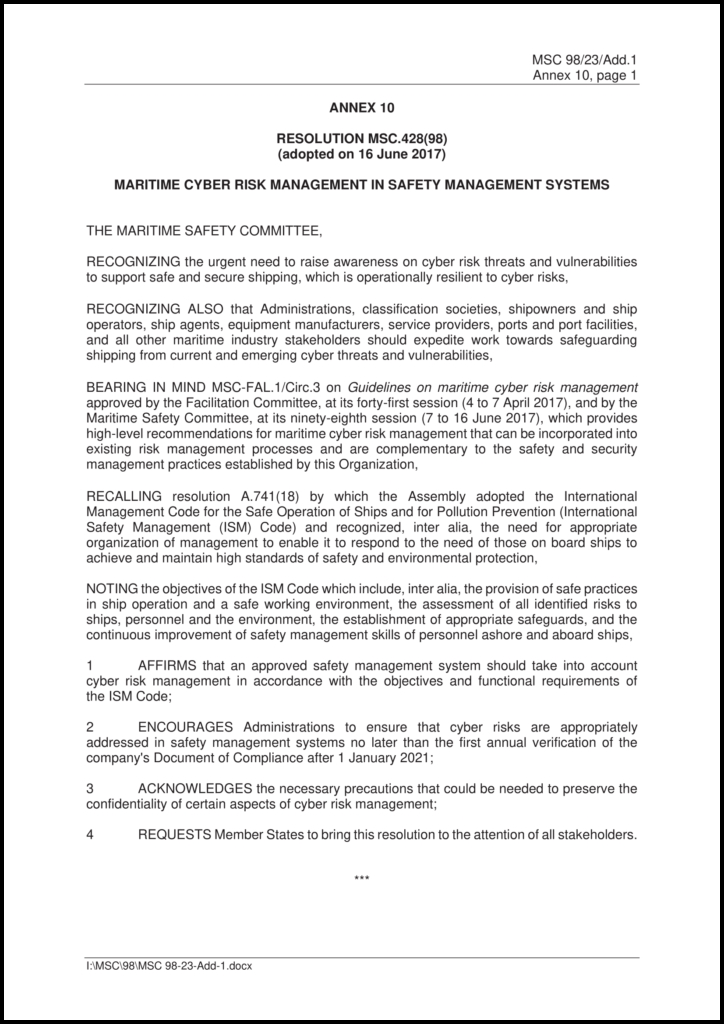
Guidelines on Maritime Cyber Risk Management MSC-FAL.1/Circ.3
Maritime cyber risk is a growing concern for the shipping industry, as ships and ports rely heavily on technology and digital systems to operate. Cyber-attacks on ships and shipping companies can have dire consequences, including loss of data, disruption of operations, and even loss of life.
The International Maritime Organization (IMO) has recognized the potential for cyber-attacks to disrupt the safe and efficient operation of ships and has taken steps to address this risk through guidelines and recommendations. The IMO issued the IMO Guidelines on Maritime Cyber Risk Management in 2017, which provide a framework for identifying, assessing, and managing cyber risks. It provides ship owners, operators, and shipbuilders with recommendations for identifying and managing cyber risks and vulnerabilities. The guidelines recommend that ship owners and operators establish a cyber risk management plan, conduct regular risk assessments, and establish procedures for incident response and recovery.
There are many concerns related to the use of cyber equipment in the maritime industry, like the increasing connectivity of ships and ports, which can provide cyber criminals with more opportunities to access and compromise these systems. The use of navigation systems, communication systems, and cargo management systems, all of which are vital for the safe and efficient operation of ships, can be disrupted by cyber-attacks. This is coupled with the lack of awareness and understanding of cyber risks among crew members, who may not be aware of potential cyber threats or know how to respond to an incident.
To address this, the IMO guidelines recommend emphasizing a risk-based approach to cyber security, which involves identifying and assessing potential cyber threats, prioritizing them based on their likelihood and impact, and taking steps to mitigate them. This includes regular security assessments, incident response planning, and training for employees on cybersecurity best practices. They also recommend increased training and awareness-raising for crew members to help them understand the risks and take appropriate actions to protect themselves and their ships.
Some important IMO guideline recommendations:
- ● the implementation of technical security measures, such as firewalls, intrusion detection systems, and encryption to help prevent cyber-attacks and limit potential damage if an attack does occur.
- ● ship and port operations develop a cyber security plan, which should include measures to protect systems and data, procedures for incident response and recovery, and regular testing and training.
- ● communication and coordination in the event of a cyber incident. This includes having established channels of communication with relevant authorities and other organizations, as well as procedures for reporting and responding to cyber incidents.
- ● the development of a cyber security management system (CSMS) that includes a risk assessment process, incident response and recovery procedures, and training and awareness-raising for crew members. Additionally, the guidelines encourage regular cyber security drills and exercises, and call for greater standardization and harmonization in the design and development of maritime systems and equipment to make it easier for ship operators to identify and manage cyber risks.
- ● ships and ports comply with the International Standards for Cyber Security for ships and ports (ISCS), which provide a comprehensive set of security controls and best practices for protecting against cyber threats.
In addition to these guidelines, the IMO has also developed a cyber security toolkit for shipping companies. The toolkit provides a comprehensive set of resources, including guidance on how to develop a cyber security management system, risk assessments, and incident response plans.
They have also developed a mandatory reporting format for ships to report cyber security incidents. This will help organizations to collect data on the types of incidents that are occurring and to identify trends and patterns, which can be used to improve cyber security in the future.
While the shipping industry has made progress in addressing cyber risks, the threat is constantly evolving, and the industry must continue to be vigilant. Shipping companies need to regularly review and update their cyber risk management plans and stay informed about the latest cyber threats and vulnerabilities. This will ensure the safety and continuity of ship and port operations and protect the lives of seafarers everywhere.
About the Author
Hussayn Gokal

